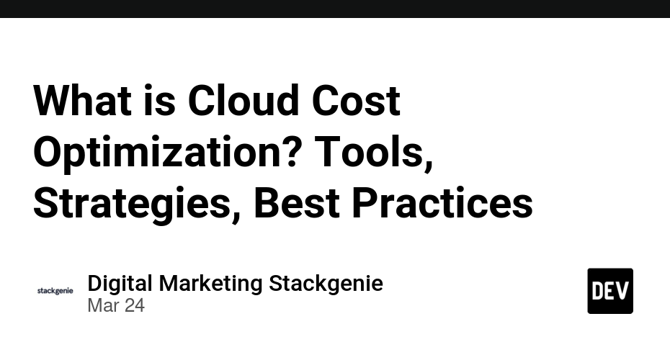Dev
4w
346

Image Credit: Dev
What is Cloud Cost Optimization? Tools, Strategies, Best Practices
- Cloud cost optimization involves strategically managing cloud resources to maximize value while minimizing unnecessary spending and ensuring cost efficiency in cloud usage.
- Key factors affecting cloud costs include idle resources, excessive resource allocation, mismanagement of reserved instances, and the cloud service pricing model.
- Strategies for cloud cost optimization include using cloud provider cost management services, implementing storage lifecycle policies, adopting a FinOps culture, and utilizing Infrastructure as Code (IaC) for cost management.
- Businesses can optimize cloud costs by adopting multi-cloud deployment for service availability, using spot instances for cost savings, network cost optimization through traffic shaping, and cloud-native re-architecture for improved performance.
- Tools like AWS Cost Explorer, Azure Cost Management + Billing, Google Cloud Platform (GCP) Pricing Calculator, and third-party tools such as CloudZero and Spot.io aid in cloud cost optimization by providing insights, estimating costs, and offering multi-cloud visibility.
- Best practices for cloud cost optimization include proactive monitoring, setting up budgets and alerts, continuous rightsizing and optimization, using tags for better cost allocation, fostering a cloud-cost-conscious culture, and collaborating between IT, finance, and development teams.
- Advanced techniques for cloud cost optimization include function-level billing audits, reducing cold-start penalties in serverless environments, optimizing network egress with custom routes, using containers for cost efficiency, and committing to reserved instances or savings plans.
- The evolution of cloud pricing models may include AI-driven cost prediction, tiered and dynamic pricing for data storage, flat-rate and subscription models for SaaS/PaaS, sustainability-linked pricing, edge and IoT-specific pricing, and marketplace-driven discounts.
- Maximizing efficiency, savings, and sustainability in cloud environments involves a proactive approach to cost management, reviewing resource allocation, automating processes, and balancing pay-as-you-go with long-term savings.
- Regularly reviewing cloud costs, implementing optimization strategies, and aligning financial goals with operational efficiency are crucial for businesses of all sizes to benefit from cloud cost optimization.
- FinOps plays a vital role in cloud cost optimization by facilitating collaboration between finance, tech, and business teams to manage spending efficiently, align financial goals with operations, and enable data-driven decisions for cost control and business growth.
Read Full Article
20 Likes
For uninterrupted reading, download the app